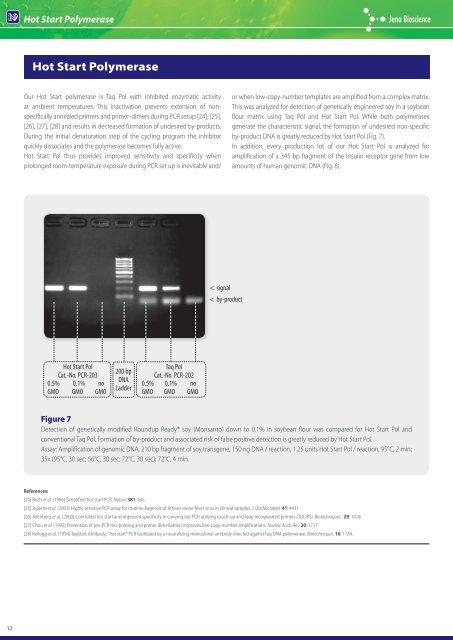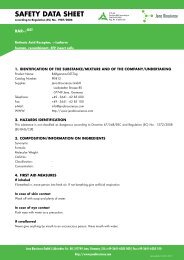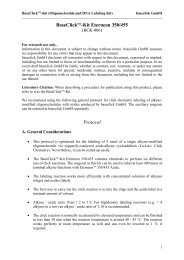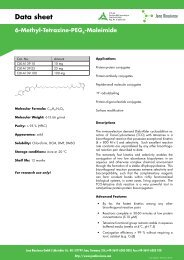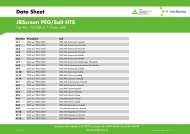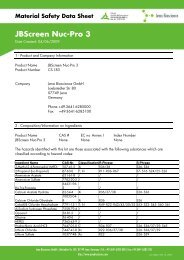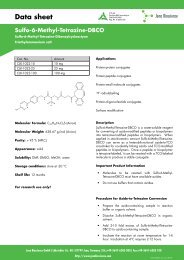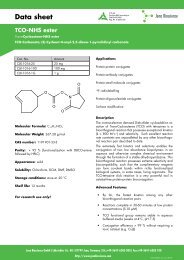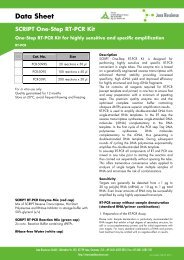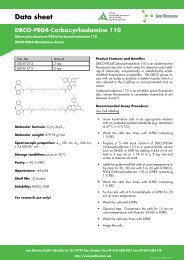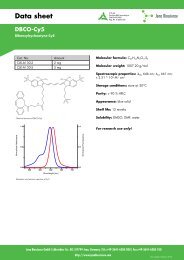Polymerase Guide - Jena Bioscience
Polymerase Guide - Jena Bioscience
Polymerase Guide - Jena Bioscience
Create successful ePaper yourself
Turn your PDF publications into a flip-book with our unique Google optimized e-Paper software.
12<br />
Hot Start <strong>Polymerase</strong><br />
Hot Start <strong>Polymerase</strong><br />
Our Hot Start polymerase is Taq Pol with inhibited enzymatic activity<br />
at ambient temperatures. This inactivation prevents extension of nonspecifically<br />
annealed primers and primer-dimers during PCR setup [24], [25],<br />
[26], [27], [28] and results in decreased formation of undesired by-products.<br />
During the initial denaturation step of the cycling program the inhibitor<br />
quickly dissociates and the polymerase becomes fully active.<br />
Hot Start Pol thus provides improved sensitivity and specificity when<br />
prolonged room-temperature exposure during PCR set up is inevitable and/<br />
Hot Start Pol<br />
Cat.-No. PCR-203<br />
0.5% 0.1% no<br />
GMO GMO GMO<br />
200 bp<br />
DNA<br />
Ladder<br />
Taq Pol<br />
Cat.-No. PCR-202<br />
0.5% 0.1% no<br />
GMO GMO GMO<br />
< signal<br />
< by-product<br />
or when low-copy-number templates are amplified from a complex matrix.<br />
This was analyzed for detection of genetically engineered soy in a soybean<br />
flour matrix using Taq Pol and Hot Start Pol. While both polymerases<br />
generate the characteristic signal, the formation of undesired non-specific<br />
by-product DNA is greatly reduced by Hot Start Pol (Fig. 7).<br />
In addition, every production lot of our Hot Start Pol is analyzed for<br />
amplification of a 345 bp fragment of the Insulin receptor gene from low<br />
amounts of human genomic DNA (Fig. 8).<br />
Figure 7<br />
Detection of genetically modified Roundup Ready® soy (Monsanto) down to 0.1% in soybean flour was compared for Hot Start Pol and<br />
conventional Taq Pol. Formation of by-product and associated risk of false positive detection is greatly reduced by Hot Start Pol.<br />
Assay: Amplification of genomic DNA, 210 bp fragment of soy transgene, 150 ng DNA / reaction, 1.25 units Hot Start Pol / reaction, 95°C, 2 min;<br />
35x (95°C, 30 sec; 56°C, 30 sec; 72°C, 30 sec); 72°C, 4 min.<br />
References:<br />
[24] Birch et al. (1996) Simplified hot start PCR. Nature 381: 445.<br />
[25] Agüero et al. (2003) Highly sensitive PCR assay for routine diagnosis of African swine fever virus in clinical samples. J Clin Microbiol. 41: 4431.<br />
[26] Ailenberg et al. (2000) Controlled hot start and improved specificity in carrying out PCR utilizing touch-up and loop incorporated primers (TULIPS). Biotechniques. 29: 1018.<br />
[27] Chou et al. (1992) Prevention of pre-PCR mis-priming and primer dimerization improves low-copy-number amplifications. Nucleic Acids Res. 20: 1717.<br />
[28] Kellogg et al. (1994) TaqStart Antibody: "hot start" PCR facilitated by a neutralizing monoclonal antibody directed against Taq DNA polymerase. Biotechniques. 16: 1134.


